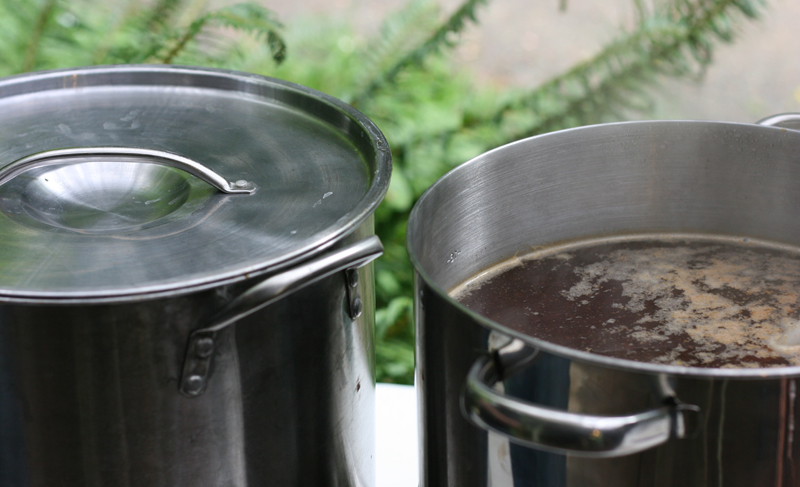Unblemished Brewing: Basic Cleaning and Sanitizing

(Photo by Colby Perry)
While one of homebrewing’s most engaging elements is its broad creative latitude, clean, sanitary techniques and conditions are two things that cannot be compromised. The two go hand in hand: Clean equipment sanitizes easily and sanitary equipment eliminates the nuisance of contamination.
Clean and sanitary are distinctly different, but symbiotic, things. Thorough cleaning eliminates the inevitable buildup of fouling chemicals or intruder-friendly fermentation residue, and proper sanitization rids your equipment of microbiological contaminants. A spoiled batch is bothersome, but a persistent systemic infection can snuff one’s brewing passion. There are a few excellent, all-purpose products that will see you through the brewing process to eliminate these headaches. A basic, versatile arsenal of products and a strategy of diligence, vigilance and elbow grease go a long way toward brewing contaminant-free beer.
Cleaning
The optimal solution to cleaning is to keep your equipment in a clean condition. Don’t let residue accumulate or dry between batches or during storage. Equipment is easier to clean after it has been used for boiling, fermenting, racking, bottling, kegging or brewing. Rinse with water (or sanitizer) when the surfaces are still wet, purging wort, beer, trub and yeast. Allow equipment to drain and air-dry before storage to discourage further microbial growth.
It is good practice to thoroughly clean (rather than simply rinse) equipment, if not between every batch, then every few. Fermenters, and sometimes kegs, will need it after every use. Beerstone (calcium oxalate and protein) is bound to build up on any surface that comes in contact with wort or beer. It can be removed with a long soak in a brewing cleanser and some scrubbing.
The most effective and versatile product for this is Powdered Brewery Wash (PBW). It is an alkaline detergent suitable for plastic, glass and stainless surfaces, an excellent cleaner for all items. It is effective in any type of water, environmentally safe and relatively cheap. After the soak, get busy with brushes or scrubbers if needed, then rinse thoroughly. B-brite and Oxygen Wash (brewing products) and plain Oxiclean are good substitutes.
Sanitizing
Obviously, all brewing equipment except the kettle must be sanitary. If everything is clean to begin with, then sanitizing should be a snap.
No-rinse sanitizers are the best and only option, in my opinion. The most effective and commonly used are iodine (BTF iodophor, Five Star IO Star) and acid agents (Star San and Saniclean). They require short contact time (minutes), eliminate the risk of rinsing and can be used on any surface without harmful effects when used at proper concentrations.
They are not, however, caveat-free. Iodine solutions lose effectiveness over time and should be used relatively fresh. The fading color is a clue to their degradation. Acid sanitizers will retain antimicrobial properties for a longer time, but cannot be used with hard water, as they will precipitate the active ingredients, rendering them useless. If the solutions are cloudy, they are ineffective.
Iodine solutions should be drained completely (drip-dried), as they will leave some residual flavor. Star San foams easily, but leaves no residual flavors. Since it is stable for a longer time, it can be used repeatedly on pre-cleaned equipment. I keep a gallon with distilled water to use as a quick surface rinse in fermenters before storage.
Sanitary Secrets
Since those opportunistic microbes are lurking everywhere, here are a few tips to stay clean and sanitary:
- Keep a spray bottle of 70 percent isopropyl alcohol or acid sanitizing solution handy for instant sanitization of surfaces or hands.
- Disassemble kegs periodically and soak the parts. This extra effort pays off. Few things are more aggravating than spending all that time carefully crafting a beer, only to have it spoil in the keg.
- Keep kegs clean by flushing with hot water and cleaner or sanitizer under pressure from your CO2 tank. Piggyback them by rigging gas and liquid fittings and tubing and run the solutions from keg to keg. BLC (Beer Line Cleaner) is specifically designed for this.
- Soak grungy bottles in any of the cleaners. Brush, rinse and dry well before you use them. When bottling time comes, a simple 2-minute sanitization will suffice.
- Use only bottles without visible residue. Rinse them right after use to prevent a buildup of contaminants, especially at the bottom.
- Pay attention to what you’re doing at all times. Sanitizing becomes a breeze once you establish a good routine and learn to minimize potential hazards.
- Invest in an auto-siphon. It will make your life a lot simpler and make racking risk-free.
- Keep your kettle spotless. That heat-induced buildup of wort, hops and burn spots during the boil may not seem like much, but it can discolor or contribute off-flavors. Bar Keepers Helper scrubbing powder is an excellent option for kettles.
- Invest in bottle, tubing and carboy brushes.
- Wild yeast is a problem, but so is carryover of yeast from previous batches. If you like to use Brettanomyces or any bacterial cultures, consider dedicating some equipment to those brews and be extra vigilant cleaning and sanitizing after using them.
- Diluted bleach is an effective cleaner and sanitizer, but needs extensive rinsing and is best limited to glass equipment and bottles.
K. Florian Klemp
K. Florian Klemp is an award-winning homebrewer.

You say using no rinse sanitizer will “eliminate risk of rinsing.” I’ve been successfully rinsing equipment for 30 years, and can’t for the life of me think of what risk doing so poses. Can you elaborate?
Hi Robert. You are correct, the risk of contamination while rinsing is minuscule, but I have always been of the opinion that any unnecessary handling of freshly sanitized surfaces poses a risk, however small. It may eliminate a potential hazard for some, experienced brewers are usually very conscious of how they handle things.